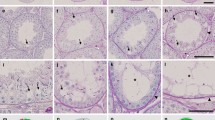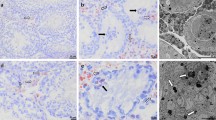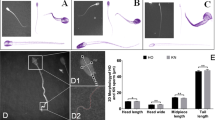Abstract
EXAMINED by electron microscopy, the central nutrient mass around which spermatogonia up to spermatozoa are attached is seen to be non-nucleated and to contain mitochondria (M, Fig. 1) and various types of nutrient spheres and vacuoles. All spermatic cells are connected to this central mass by bridges (J, Fig. 1) which become much attenuated as the spermatic cells develop. The central nutrient mass is developed in the middle of the spermatogonial syncytium during early growth stages of the spermatocytes, and through these bridges all cells draw upon this store equally for their development into spermatozoa, thus being kept in step.
This is a preview of subscription content, access via your institution
Access options
Subscribe to this journal
Receive 51 print issues and online access
$199.00 per year
only $3.90 per issue
Buy this article
- Purchase on Springer Link
- Instant access to full article PDF
Prices may be subject to local taxes which are calculated during checkout
Similar content being viewed by others
References
Chatton, E., and Tuzet, O., C.R. Acad. Sci., Paris, 213 (1941).
Author information
Authors and Affiliations
Rights and permissions
About this article
Cite this article
GATENBY, J., DALTON, A. Origin and Connexions of the Central Nutrient Mass in Lumbricus Spermatogenesis. Nature 182, 886–887 (1958). https://doi.org/10.1038/182886a0
Issue Date:
DOI: https://doi.org/10.1038/182886a0
Comments
By submitting a comment you agree to abide by our Terms and Community Guidelines. If you find something abusive or that does not comply with our terms or guidelines please flag it as inappropriate.



